(email exchange)
>
> On Mon, Mar 9, 2009, Mauer wrote:
>
> And then there’s this, which nobody focused on last week, fixating instead on the employment
> numbers.
>
Yes, another indicator moving sideways rather than down.

[top]

(email exchange)
>
> On Mon, Mar 9, 2009, Mauer wrote:
>
> And then there’s this, which nobody focused on last week, fixating instead on the employment
> numbers.
>
Yes, another indicator moving sideways rather than down.

[top]
Maybe the ECB is quietly asking their banks to reduce their USD borrowings, causing them to bid up USD LIBOR?
[top]
Let your Washington contacts know I’m available to help them formulate their questions!
SENATE COMMITTEE ON THE BUDGET HOLDS A HEARING ON ECONOMIC AND BUDGET CHALLENGES
MARCH 3, 2009
WITNESSES:
FEDERAL RESERVE SYSTEM BOARD OF GOVERNORS
CHAIRMAN BEN BERNANKE
GREGG: Thank you, Senator Wyden.
And thank you, Mr. Chairman, for attending this hearing today.
I think Senator Wyden, as acting chairman, has touched a core of one of the primary issues I’m interested in, which is the question of confidence. Whether or not the economy recovers depends in large part on the confidence of the American people in the value of their homes and in the fact that they’ll keep the job, confidence of those people
who buy our instruments that are debt is solid and sound, confidence that our currency is strong.
Wrong. It depends on having sufficient income to buy their own outputs and to net save as desired.
In the short run, one can accept the fact that debt is going to go up significantly because of the need to address this economy with the liquidity that only the government can put into it.
But in the long run, one has to ask how can this country sustain a debt to GDP ratio of 67 percent, deficits of over 3 percent, or as far as the eye can see, and expect to maintain the value of the dollar or the ability of people to come and buy our debt?
Like Japan? The yen seems strong enough to me with ratios twice that high.
There is a tsunami of debt headed at us — $66 trillion in unfunded liability. It will essentially overwhelm the capacity of our children to pay it and the ability of this nation to sustain it.
The usual mainstream nonsense.
BERNANKE: By December the Federal Open Market Committee had brought its target for the federal funds rate to an historically low range of zero to .25 percent, where it remains today.
(Which has removed maybe $200 billion annually in net interest income for the non government sectors)
Unfortunately,
Here we go. Deficits per se are bad.
the spending for financial stabilization, the increases in spending and reductions in taxes associated with the fiscal package, and the losses in revenues and increases in income- support payments associated with the weak economy will widen the federal budget deficit substantially this year. Taking into account these factors, the administration recently submitted a proposed budget that projects the federal deficit to increase to about $1.8 trillion this fiscal year and to remain around $1 trillion in 2010 and 2011.
As a consequence of this elevated level of borrowing, the ratio of federal debt held by the public to nominal GDP is likely to move up from about 40 percent before the onset of the financial crisis to more than 60 percent over the next several years, its highest level since the early 1950s, in the years following the massive debt buildup
during World War II.
Of course, all else equal, this is a development that all of us would have preferred to avoid.
He’s obviously in a fixed FX paradigm
We are better off moving aggressively today to solve our economic problems. The alternative could be a prolonged episode of economic stagnation that would not only contribute to further deterioration in the fiscal situation,
As if that’s the larger issue
but would also imply lower output, employment and incomes for an extended period.
Of secondary importance to the deficit issue.
With such large near-term deficits, it may seem too early to be contemplating the necessary return to fiscal sustainability. To the contrary, maintaining the confidence of the financial markets requires that we begin planning now for the restoration of fiscal balance.
Not true.
As the economy recovers and resources become more fully employed, we will need to withdraw the temporary components of the fiscal stimulus. Spending on financial stabilization also must wind down. If all goes well, the disposition of assets acquired by the Treasury in the process of stabilization will be a source of added revenue for the Treasury in the out years.
How about instead:
Whatever it takes to sustain output and employment is the right fiscal and policy.
Determining the pace of fiscal normalization will entail some difficult judgments. In particular, the Congress will need to weigh the costs of running large budget deficits for a time
What costs?
against the possibility of a premature removal of fiscal stimulus that could blunt the recovery.
That’s a real cost.
We at the Federal Reserve will face similar difficult judgment calls regarding monetary policy.
In particular, policy-makers must remain prepared to take the actions necessary in the near term to restore stability to the financial system and to put the economy on a sustainable path to recovery. But the near-term imperative of achieving economic recovery and the longer-run desire to achieve programmatic objectives should not be allowed to hinder timely consideration of the steps needed to address fiscal imbalances.
Why are they imbalances???
There are no gold reserves that can be depleted due to a convertible currency.
Without fiscal sustainability,
Fortunately, that isn’t an operational issue.
in the longer term we will have neither financial stability nor healthy economic growth.
Thank you for your attention. I’m happy to take your questions.
Senator Gregg?
GREGG: Thank you, Mr. Chairman.
And after that is all said and done, four years from now, when one certainly hopes, presumes and expects that we will be beyond these dire economic situations, we will be looking at a government which is taking up 22 percent of the gross national product,
(Probably the lowest in the world)
has a 67 percent ratio of publicly held debt to the GDP, and no end in sight and, in fact, it continues to work its way up, with deficits running at three to four percent, minimum, from 2013 to 2019, which is the end of the
window for this budget.
Reads like conditions for stability to me.
BERNANKE:GREGG: But your place is to protect the value of the dollar and protect the ability …
GREGG: … to sell the debt…
BERNANKE: … go on to say my concern here, as I expressed, was that there needs to be fiscal sustainability. If government spending is higher, it needs to be recognized that that will involve higher taxes in order to maintain a close reasonable balance between revenue and outlays.
So his target is a ‘close reasonable balance’.
That does have some implications for efficiency of the economy.
Does have some implications for efficiency? Is that all? Not that there is such a thing in the first place.
BERNANKE: Well, Senator, the CBO, for example, has done simulations which show that in 2030, under current laws, Medicare, Medicaid and Social Security would take up about, alone, would take up about 16 percent of GDP, which is pretty close to non-interest spending. It’s pretty close to the entire federal non-interest budget.
So it’s clear that in order to get control over the overall budget situation, we’re going to need to look at entitlements.
We don’t have the real resources to give the elderly a modest minimum standard of living and we don’t have the real resources to look after our health???
The current excess capacity alone is more than enough to do both.
If we don’t get a sustainable fiscal situation and deficits continue in large amounts for a long period, then it will become more difficult to sell our debt and interest rates will rise and it will be counterproductive.
Like Japan?
BERNANKE:Yes. So there’s been a lot of talk about banks and their ability to lend. In fact, for many types of credit, nonbank securitization markets are the main source of funding and those markets have largely closed down.
And so by restoring and re-stimulating activity in securitization markets, we hope to get credit flowing for a number of different critical areas.
We can’t ‘get credit going’ without securitization?
Of course we can!
The Fed could easily enable the banks, their legally designated agents, to do this with similar funding and guarantees.
Senator Cardin?
GRAHAM: Thank you, Mr. Chairman.
I’m trying to ask Senator Gregg’s question a little bit differently. Is there any outer limit on the federal government’s ability to borrow money?
BERNANKE: Certainly, there are outer limits.
Really??
GRAHAM: What are they and how close are we to them?
BERNANKE:Well, it’s — it’s hard — it’s hard to — to judge in any kind of explicit way, since we don’t — don’t know. I mean there are countries have clearly — for short periods of time has clearly had very high levels of debt.
Like Japan? For almost 20 years?
The United States had more than 100 percent debt to GDP ratio during World War II. The Japanese during their financial crisis raised the debt to GDP ratio above 100 percent.
Above 150% for considerable periods of time.
But clearly, that’s not a healthy situation.
Clearly?
It’s one in which interest payments can become a very important part of the — of the government’s outlays.
The Fed sets those interest rates. And Congress taxes interest income.
Nor operationally is the ability to make payments revenue constrained.
We had been — over years had been bringing our debt to GDP ratio down to about 40 percent. Now we’re going to see a jump to 60 or 65 percent.
We need to be I think looking for a — what’s called a primary deficit — that is, the deficit excluding interest payments, a somewhere close to balance. That would be sufficient to stabilize our debt to GDP ratio. I think that would be a good objective.
Interesting, more gold standard rhetoric.
How about an objective like optimal output and employment?
It’s very hard to know how much higher — how much higher the debt to GDP ratio could be before the international financial markets begin to — to balk. And so I think the prudent thing to do is to try and maintain stability of the debt to GDP ratio.
Like Japan, where 10 year JGB’s are under 1.5%, outstanding securities are over 150% of GDP, deficits range to over 8% of GDP, and they’ve been downgraded below Botswana???
Government rates go to where the CB sets them, end of story.
GRAHAM: Has there always been a buffer zone to — between reality and this magical place? And is there a buffer zone today?
BERNANKE: Well, as — as I think the recent experience is showing, confidence and expectations are critical.
Yes, he truly believes this.
And I think the markets will be quite able to absorb, for example, the large amount of issuance we’re seeing in the next couple of years, if there is a reasonable expectation and confidence in the same markets that the United States is serious about getting its budget position under control in the longer-term.
He truly believes that’s the case.
GRAHAM: There are some projections that exist that in 2050 the debt to GDP will be 300 percent. What kind of effect will that have, if that became a reality?
BERNANKE: Well, I don’t think that’s going to happen. It can’t happen, because things would break down before then.
GRAHAM: Something has to change first.
BERNANKE: Something…
GREGG: Happen, but not to change.
BERNANKE:That’s right.
GREGG: For it not to happen, right? Something has to change.
BERNANKE: Something would change, whether it was either change in policy or change in the willingness of the — of the lenders to finance the debt.
What generally changes is inflation keeps the nominal debt to GDP ratio down, but that’s another story that he knows well. And the reason he doesn’t want to go there is because that story says the risks are inflation and not solvency or the ability to sell securities.
GRAHAM: I’ve only got 15 seconds. My question, basically, is will we ever know in this country whether or not we’re repeating the Japanese mistake? Do you have any test out there to let us in Congress know that we’re throwing good money after bad, when it comes to certain institutions?
BERNANKE: The Japanese mistake was not acting quickly enough or aggressively enough, and I think that’s not our problem.
Yes, on fiscal policy.
SANDERS: Thank you, Mr. Chairman.
ALEXANDER: But — but they are (inaudible) to — to specify — the first risk is that you don’t get your money back. You think you will. The second risk would be that you’d — the more paper — the more money you print, the more likely we have inflation down the road…
(CROSSTALK)
BERNANKE: Senator, that’s aptly correct. So you’re absolutely right that in order for us to begin to raise interest rates and begin to stabilize the economy.
Now that they can pay interest on reserves they don’t have to ‘shrink the balance sheet’ to raise rates. Bernanke should know that.
At that time when the economy begins to grow again, we’re going to have to shrink the balance sheet and we are very comfortable — we’re watching that very, very carefully. It’s very important. We spend about half of our time at FOMC meetings, looking at the balance sheet and trying to make that evaluation.
Interesting use of FOMC time!
Worrying about something of no consequence whatsoever.
[top]
NYC defaulted when I first started in the early 70’s.
Charlie Sanford, my department head at Banker’s Trust, was the one who pulled the plug.
He was at a meeting for a revenue anticipation bond and said in his distinctive voice something like, “Revenue, what revenue? We’re out.”
>
> On Tue, Mar 3, 2009 at 10:35 AM, Russell wrote:
>
> Gambling man?
>
50% Chance NYC Will Default on Its Debt in 5 Years
by Joe Weisenthal
Mar 3 (Business Insider)
[top]
This is relentless and tends to cushion downturns:
Personal Income and Outlays
Mar 2 (BEA) — Personal current transfer receipts increased $66.6 billion in January, compared with an increase of $29.9 billion in December. The January change in current transfer receipts reflected 5.8-percent cost-of-living adjustments to social security benefits and to several other federal transfer payment programs; together, these changes added $41.1 billion to the January increase.
Government wage and salary disbursements increased $12.9 billion in January, compared with an increase of $1.4 billion in December. Pay raises for civilian and military personnel added $9.7 billion to government payrolls in January.
[top]
BROWN: Specifically, what worked that Roosevelt did? What did we learn from that? What worked that applies to now?
BERNANKE: Well, there were two things that he did almost within months of taking office that were extremely important. One was the bank holiday and the subsequent measures, like the deposit insurance program that stabilized the banking system.
Yes, deposit insurance allowed banks to fund themselves on an unsecured basis via federal deposit insurance.
The lesson was the liability side of banking is not the place for market discipline.
Which is why I’ve been proposing all along that the Fed needs to get immediate permission from Congress to lend to member banks on an unsecured basis. This would instantly clear up the interbank lending issues.
The problem is the FOMC doesn’t understand reserve accounting and how the monetary system actually works.
And it’s a point I’ve been making all morning, that we need to stabilize the banks.
And they need borrowers to have sufficient net incomes to make their payments. Hence my payroll tax holiday.
The second thing he did was to take the U.S. off the gold standard, which allowed the Federal Reserve to ease monetary policy, allowed for a rise in prices, which, after three years of horrible deflation, allowed for recovery.
Yes, it removed the supply side constraints on the ‘money supply’ with the gold standard this constraint makes it problematic for even the Treasury to fund its deficit spending, as competition to borrow a finite amount of reserves drives up interest rates.
When the currency is instead allowed to float interest rates are then instead set by the government rather than market forces. This allows the Fed to cut rates and the Treasury to deficit spend without risking the loss of gold reserves.
So those were the two perhaps most important measures that he took.
He did some counterproductive things, like the National Recovery Act, which put the floors under prices and wages and prevented necessary adjustment.
Excuse me??? His new Keynesian roots are showing. They believe lower wages will allow labor markets to ‘clear’ when deficits are too small to support demand.
The most controversial issue recently, of course, has been fiscal policy and I think there are two sides to that.
The classic work on this by an old teacher of mine from MIT, E. Cary Brown, said that fiscal policy under Roosevelt was not successful, but only because it wasn’t tried, and he argued that it wasn’t big enough relative to the size of the problem.
True!
Other people, other writers have argued that this wasn’t the right medicine.
So that one is more controversial, but if you ask me what I think the most important things were, I think they had to do with stabilizing monetary policy and stabilizing the financial system.
Which he hasn’t yet been able to do.
[top]
(email exchange)
As I’ve said all along, the problem is best addressed from the bottom up- restore incomes and employment via a payroll tax holiday and a check for $300 billion for the states.
That ends the financial crisis and its effect on the real economy.
Then Congress attempt to rationally address other fiscal action on its merits beyond fixing the crisis.
>
> On Thu, Feb. 12, Morris wrote:
>
> Part of the problem the banks confront is that their
> loans continue to deteriorate. This limits their ability
> to initiate new loans, makes them tighten lending
> standards and clouds their business visibility. The
> proper visual is a ship taking on water while the
> crew is trying to bail out the ship. If the ship takes
> on water too quickly it will sink, if the crew can plug
> the whole and bail out the ship the ship will float.
> This is state of affairs of most banks at the
> moment. The ultimate success of these bailouts &
> workouts will take hold when the rate of credit
> deterioration slows or stops.
>
Ross Says Investors Will Wait for Bank Writedowns
by Jason Kelly and Carol Massar
Feb 12 (Bloomberg) — Wilbur Ross, the billionaire investor who focuses on distressed assets, said private funds won’t join President Obama’s plan to buy toxic mortgages until banks reduce the value of the
securities on their books.
“The reason the assets haven’t changed hands is they haven’t been
properly marked,” Ross said in an interview with Bloomberg Television
yesterday at his New York office, referring the process of valuing investments based on market prices. “His idea of doing public/private partnerships is correct. The private sector is very good at price
discovery.”
[top]
The 18m into 1yr FRA-OIS is now 51 bps mid vs 40 in January
The FRA-OIS curve has steepened since January
Mar 09 1) 90.00
Jun 09 2) 83.38
Sep 09 3) 78.50
Dec 09 4) 81.50
Mar 10 5) 63.00
Jun 10 6) 55.00
Sep 10 7) 47.00
Dec 10 8) 47.00
Mar 11 9) 35.00
Jun 11 10) 28.00
Sep 11 11) 26.00
Dec 11 12) 32.00
Mar 12 13) 34.00
Jun 12 14) 29.00
Sep 12 15) 29.00
Dec 12 16) 28.00
Mar 13 17) 30.00
Jun 13 18) 28.00
Sep 13 19) 28.00
The Jun11 and Sept11 FRA-OIS is pricing in virtually zero term premium for 3mLIBOR
Meanwhile front end OIS spreads have widened by 9 making the “roll-up” more attractive
3mLIBOR did find a floor in the 1% area as we expected (at least so far…):

Option on continued financial distress and/or a new paradigm for FF-LIBOR spreads.
From a fundamental standpoint the forward timing of these spreads coincides with termination of TLGP guarantee issuance and other Fed/Trsy financial support programs.
Mar09 (Front)

Jun11 (sweet spot)
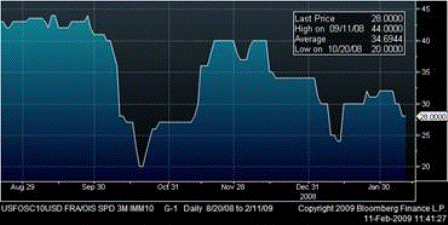
Fed Funds effective rate currently 9bps:
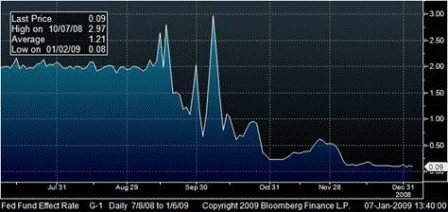
But where will 3m LIBOR be? Currently 1.3975%.
Thus current spot setting is 130bps.
Front rolling OIS-LIBOR:
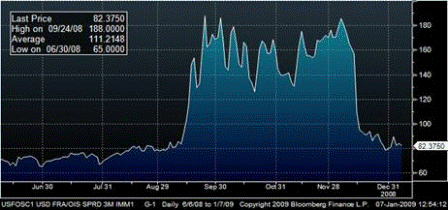
5th rolling OIS-LIBOR:
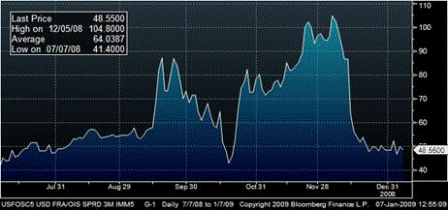
9th rolling OIS-LIBOR:
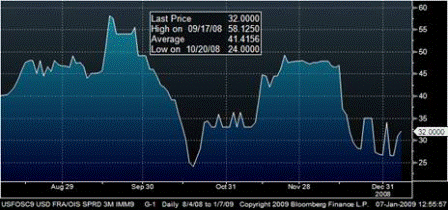
The long term floor for FF-LIBOR has been 12-15bps:
1y FF-LIBOR basis swap:
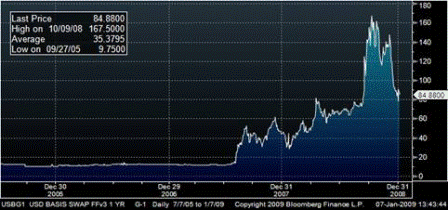
Banks are still not lending to each other unsecured for term.
The term premium for funding will remain steep as long as financials want to keep flexibility in their cash holdings.
The premium for term LIBOR is further supported by the level of financial CDS:
It is hard to imagine banks lending to each other at levels below those implied by CDS (unless Government or FDIC guaranteed):
| BANK | 5yr CDS |
| American Express | 245.6 |
| BBVA | 81.1 |
| BNP | 59.1 |
| Banco Santander | 82.2 |
| Bank of America | 110.1 |
| Barclays | 140.5 |
| Citigroup | 164.5 |
| Commerzbank | 73.1 |
| Credit Agricole | 69.2 |
| Credit Suisse | 165 |
| Deutsche Bank | 119.600 |
| Goldman | 246.3 |
| HSBC | 90.1 |
| ING | 113.2 |
| JPMorgan | 110.1 |
| Opec Country | Jan Est. |
| Lloyds TSB | 93 |
| Merrill Lynch | 112.5 |
| Morgan Stanley | 357.4 |
| RBS | 112.8 |
| Soc Gen | 95.3 |
| UBS | 194.7 |
| UniCredit | 104.7 |
| Wachovia | 111.4 |
| Wells Fargo | 110.1 |
| Average | 131.7333 |
[top]
Seems government has it wrong again?
First, government has not acted to sustain aggregate demand- the primary economic responsibility of a taxing authority.
Yes, it’s sort of trying in bits and pieces, but has not taken immediate action to restore demand at levels at least 5% higher than where it is currently.
What banks need most is borrowers who have the income to afford their payments.
This is a simple matter of immediate tax cuts as well as sustaining funding for desired government services.
This requires nothing more than data entry on their sterling spread sheet.
Regarding current bank solvency issues:
If the UK government wants its banks to continue to function they can do that by simply providing unsecured loans from the BOE to fund bank operations, including lending.
No bank need ever shut down if government understands its role of not making the liability side of banking the place for market discipline.
Government can and does outlaw any banking activity if deems does not meet the test of public purpose.
Bank capital is the loss buffer between losses and government guaranteed deposits.
If bank capital is below required government standards (presumably determined for public purpose) all that means is any risk of loss for the bank is that much closer to being a loss for the government.
Adding government capital doesn’t change that, so it’s redundant in that sense.
If the government wants to sustain the operations of a private bank with deficient capital and there is no private risk capital available, it does so (for what they determine to be further public purpose) at risk of loss.
Any such loss to government is the ‘cost’ of the public purpose of sustaining those banking services, just like other public services have ‘costs’ such as the military, public roads, etc.
(At the macro level, the real costs are the real resources tied up in banking vs the real benefits of enhanced useful output.)
What to do with the UK banking system?
They have all kinds of VAT type taxes that can be adjusted to immediately restore spending power and enable borrowers to make their loan payments.
Waiting for current fiscal measures to do this will eventually work through the ‘automatic stabilizers’ but will take a lot longer with a much higher loss of real output.
Some of this is happening, but it is not organized around an expressed agenda of ‘further public purpose’.
A clear vision statement regarding public purpose itself serves public purpose.
Unfortunately, the institutional structure in the eurozone does not allow for this type of government response.
They have to rewrite the treaty or wait through an ugly deflationary contraction for exports to recover, providing market participants continue to support them, which is doubtful at best.
(As always, feel free to distribute)
Irish, British Banks Head Towards Zero On Nationalization Concerns
Jan 19 (Global Economic Analysis) — Equity prices in the three remaining Publicly Traded Irish Banks Collapse after Anglo Irish Bank was nationalized.
In afternoon trade, Allied Irish shares were down 62%, Bank of Ireland fell 49% and mortgage and insurance specialist Irish Life & Permanent dropped 41%.
Analysts said shares in Allied Irish and Bank of Ireland were being hit particularly hard because of growing investor fears that the banks’ existing shares will be heavily diluted when both banks formally accept billions in government investment this spring. Shares in the Dublin-based bank had fallen 98% over the past year on the back of bad debts and corporate scandal.
The government had previously proposed taking a 75% stake in Anglo Irish at a cost of 1.5bn euros (£1.36bn; $1.97bn). But it dramatically opted for a full takeover on Thursday, on the eve of an emergency shareholder meeting called to approve the earlier government investment.
Nationalization Concerns Sink RBS
Bloomberg is reporting RBS Plummets Amid Concern Bank May Be Nationalized.
Royal Bank of Scotland Group Plc slumped by the most in two decades in London trading on concern the government may have to take full control of the bank after forecasting the biggest loss ever reported by a U.K. company.
The stock dropped 67 percent, the most since September 1988, to 11.6 pence, paring the Edinburgh-based lender’s market value to 4.6 billion pounds ($6.7 billion).
[top]